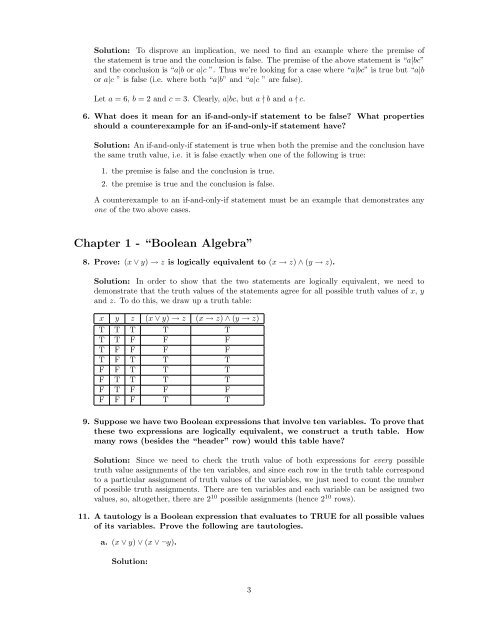Homework #2: Solutions Chapter 1 - “Theorem”
Homework #2: Solutions Chapter 1 - “Theorem”
Homework #2: Solutions Chapter 1 - “Theorem”
You also want an ePaper? Increase the reach of your titles
YUMPU automatically turns print PDFs into web optimized ePapers that Google loves.
Solution: To disprove an implication, we need to find an example where the premise ofthe statement is true and the conclusion is false. The premise of the above statement is “a|bc”and the conclusion is “a|b or a|c ”. Thus we’re looking for a case where “a|bc” is true but “a|bor a|c ” is false (i.e. where both “a|b” and “a|c ” are false).Let a = 6, b = 2 and c = 3. Clearly, a|bc, but a ∤ b and a ∤ c.6. What does it mean for an if-and-only-if statement to be false? What propertiesshould a counterexample for an if-and-only-if statement have?Solution: An if-and-only-if statement is true when both the premise and the conclusion havethe same truth value, i.e. it is false exactly when one of the following is true:1. the premise is false and the conclusion is true.2. the premise is true and the conclusion is false.A counterexample to an if-and-only-if statement must be an example that demonstrates anyone of the two above cases.<strong>Chapter</strong> 1 - “Boolean Algebra”8. Prove: (x ∨ y) → z is logically equivalent to (x → z) ∧ (y → z).Solution: In order to show that the two statements are logically equivalent, we need todemonstrate that the truth values of the statements agree for all possible truth values of x, yand z. To do this, we draw up a truth table:x y z (x ∨ y) → z (x → z) ∧ (y → z)T T T T TT T F F FT F F F FT F T T TF F T T TF T T T TF T F F FF F F T T9. Suppose we have two Boolean expressions that involve ten variables. To prove thatthese two expressions are logically equivalent, we construct a truth table. Howmany rows (besides the “header” row) would this table have?Solution: Since we need to check the truth value of both expressions for every possibletruth value assignments of the ten variables, and since each row in the truth table correspondto a particular assignment of truth values of the variables, we just need to count the numberof possible truth assignments. There are ten variables and each variable can be assigned twovalues, so, altogether, there are 2 10 possible assignments (hence 2 10 rows).11. A tautology is a Boolean expression that evaluates to TRUE for all possible valuesof its variables. Prove the following are tautologies.a. (x ∨ y) ∨ (x ∨ ¬y).Solution:3
















